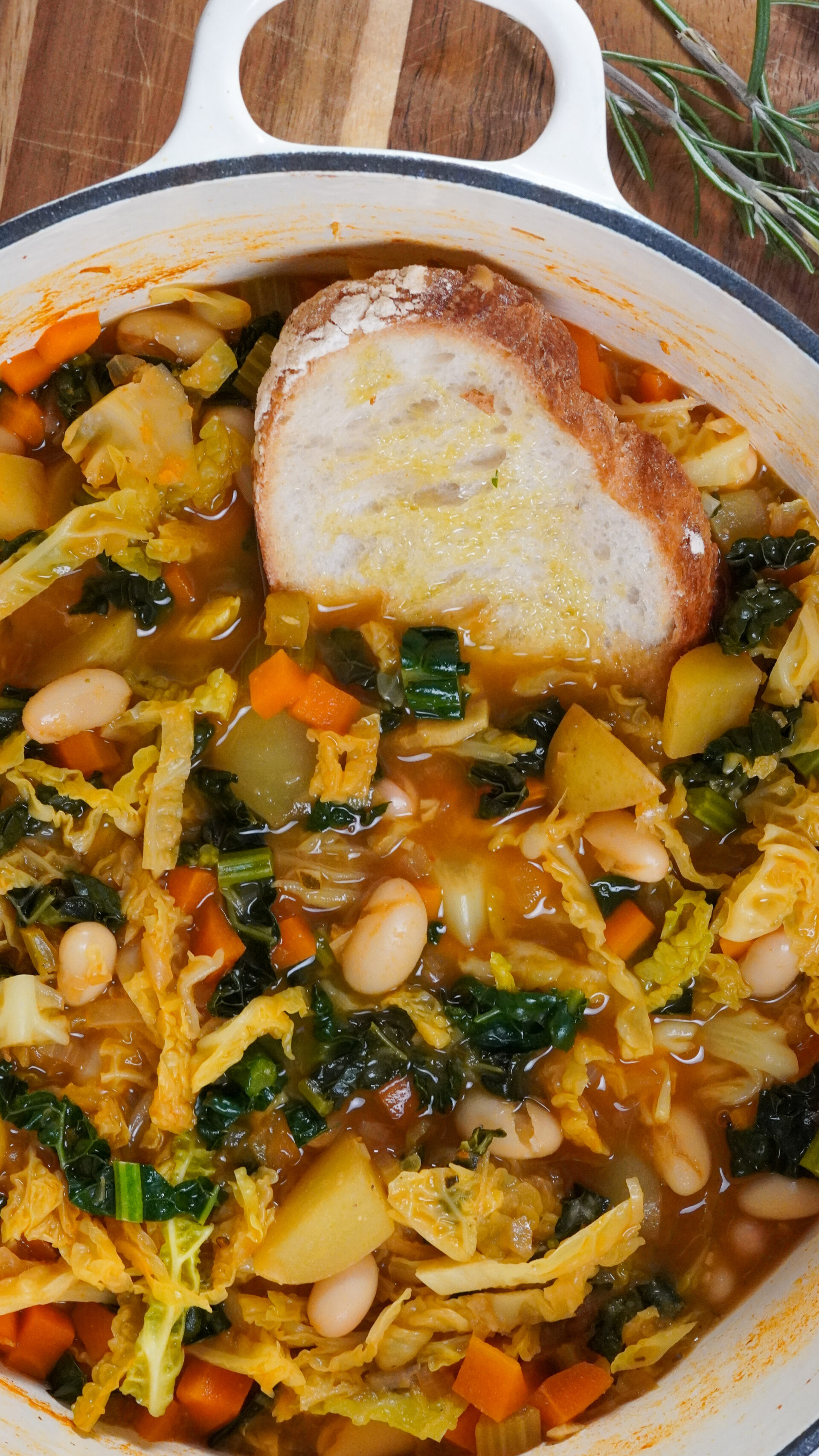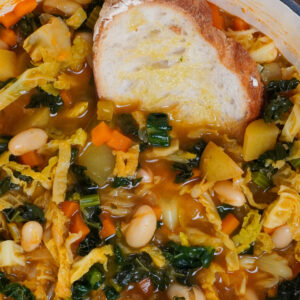Ribollita is a timeless Tuscan dish that perfectly embodies the essence of Italian cooking: simplicity, resourcefulness, and heartwarming flavours. The name means “reboiled,” as it was originally made by reheating leftover vegetable soup with stale bread for a comforting, hearty meal.
This one-pot wonder is packed with seasonal vegetables, creamy cannellini beans, and the perfect balance of herbs, making it a nourishing meal for chilly days. While tradition suggests letting the soup rest overnight for even deeper flavours, it’s undeniably delicious straight from the pot.
Serve it ladled over crusty sourdough for that authentic Tuscan touch. Simple, healthy, and satisfying—this is comfort food at its finest.

What Is ‘Ribollita’?
‘Ribollita’ is a rustic Tuscan soup whose name means “reboiled” — and that’s exactly how it was traditionally made. Dating back to medieval times, it began as a way for peasants to stretch leftovers. They would take yesterday’s vegetable soup and reheat it with stale bread, transforming it into a thick, comforting dish.
In traditional Tuscan cooking, cavolo nero (=Tuscan Kale, black kale) is a staple in soups and it is a key ingredients to make Ribollita. Cavolo Nero adds depth, heartiness, and a slightly earthy flavour. It’s known for holding its texture even after long simmering, which is why it’s perfect in dishes that get better with time, so it is define
This humble soup is a beautiful example of cucina povera — Italy’s resourceful “poor cooking” — where nothing was wasted, and simple ingredients like beans, cabbage, and day-old bread were turned into something truly nourishing.Ribollita wasn’t just practical; it brought families around the table, again and again.
Over time, ribollita went from a clever way to use up leftovers to one of Tuscany’s most loved dishes. It’s just veg, beans, and bread — nothing fancy — but together, they create something so comforting and full of flavour. It’s the kind of meal that makes you feel good, and that’s why it’s still around today.
Gut-Friendly
Ribollita isn’t just a delicious piece of culinary history — it’s also a modern-day superfood. Its plant-based ingredients align perfectly with the dietary patterns observed in the Blue Zones, regions known for their high numbers of centenarians. In these areas, diets are predominantly plant-based, rich in vegetables, legumes, and whole grains, with minimal processed foods and meat.
Moreover, ribollita supports the “30 plants a week” recommendation by leading nutritionists and recent research, which suggests that consuming a variety of plant foods can boost gut health and overall well-being. A study from the American Gut Project found that individuals who ate a diverse range of plant foods had a more diverse gut microbiome, leading to better digestion and health.
Tips
- In the UK, cavolo nero is in season from September to March, with its peak months from November to February.
- To save time I have used canned cannellini beans, are a great shortcut! To make a more authentic version you can cook the beans from scratch (instruction below).
- I’m using lots of vegetables here, and cabbage adds a lot of volume, so I recommend using a larger casserole dish than usual. I used a 4-litre, 36cm cast-iron casserole.
- This recipe includes the traditional ingredients used in ribollita, but if you have any leftover vegetables in the fridge, feel free to add them to the soup! The more vegetables, the greater the variety of plants — and the better for your gut health!
- Traditionally, Ribollita is left in the fridge overnight to let the flavours deepen and meld together, making it even more comforting the next day, which means it makes a great prep ahead meal and leftover are always welcome! To enjoy this dish you don’t have to wait the next day though, serve piping hot as soon as it is ready.
How To Cook Cannellini Beans From Scratch
To cook dry cannellini beans, first rinse and sort them to remove any debris. Soak the beans overnight in water, then drain. Place the soaked beans in a pot, cover with fresh water (3-4 cups of water per cup of beans), and bring to a boil. Reduce to a simmer and cook for 60-90 minutes, or until tender.
Swaps
Savoy cabbage: this type of cabbage is much softer than the most common white cabbage, which makes it perfect for this dish. You could swap savoy for white cabbage, in which case I would cook it a little longer to soften, as their leaves are a much crunchier.
Cannellini beans: these are the traditional beans used and my preferred type for consistency and size. If you don’t have cannellini beans try any other type of beans: butter beans or chickpeas would be my second and third choice.
Storage
Store them in an airtight container, such as a glass jar or resealable bag at room temperature or fridge. This helps retain their crunch and prevents moisture from getting in. If you keep at room temperature the maple syrup will melt slightly and become sticky but still totally delicious.
More Gut-Friendly Soups Ideas
- Gut Health Soup
- Amazing Chickpea Soup
- Zuppa alla Garfagnina (Tuscan Spelt and Bean Soup)
- Winter White Soup

Ribollita (Italian Vegetable & Bread Soup)
Ingredients
- 1 can cannellini beans
- 1/2 savoy cabbage chopped
- 5 leaves cavolo nero chopped
- 2 garlic cloves finely chooped
- 5 baby potatoes
- 1 celery chopped in small cubes
- 1/2 yellow onion
- 1 tbsp tomato paste
- 3 leaves sage finely chopped
- 1 small steam rosemary finely chopped
- 800 ml boiling water + 1 tbsp vegetable stock
Instructions
- Sauté onion, carrot, celery, garlic and potatoes in olive oil. Add tomato paste and herbs and cook until softened.
- Add the vegetables – stir in chopped savoy cabbage, cavolo nero and simmer.
- Meantime, in a blender add: beans and water: blend until smooth.
- To the casserole add half of the cannellini beans, and the blended beans too.
- Pour the stock and simmer until everything is tender and hot then season to taste with salt and pepper *
- Serve on a bowl with stale or crunchy sourdough bread and pour the soup all over.
